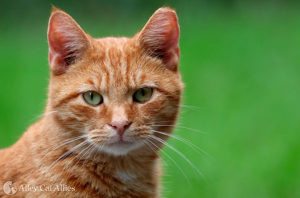Miracle is, in most ways, a typical community cat. Since Alley Cat Allies staff rescued her from the median of a busy highway in January 2018, she has lived a happy, healthy life outdoors on caregiver Mike Muchler’s property in Galloway Township, New Jersey. Other cats have started to hang out with Miracle, developing their own family group, or colony. Miracle has shelter. She is fed daily. And she’s FeLV positive.
FeLV, or Feline Leukemia Virus, and FIV, or Feline Immunodeficiency Virus, are two viruses that are often misunderstood, especially in community cats. Alley Cat Allies regularly fields questions from community cat caregivers about FIV- or FeLV-positive cats they care for. FIV- and FeLV-positive community cats, like Miracle, can live healthy lives outdoors as part of Trap-Neuter-Return (TNR) programs. It’s important to note that community cats and owned cats have equally low rates of disease.

Community cats can live full, healthy lives in their outdoor homes.
What Is FeLV in Cats?
FeLV is a cancer-causing virus that suppresses the immune system. It is spread primarily through cats’ saliva. Most cats acquire the virus from their infected mothers at birth or through prolonged direct contact, such as mutual grooming. It can also spread through bite wounds and rarely through the shared use of litter boxes or feeding dishes.
FeLV is the most common cause of cancer in cats. Some cats who are exposed to FeLV develop a transient viral infection, fight the virus, and become immune. Some cats will remain infected but may not develop symptoms for years if at all. In some cats, the virus will eventually threaten their immune system and FeLV-related diseases will develop. Miracle’s caregiver should look out for:
- Loss of appetite
- Weight loss
- Poor coat condition
- Persistent fever
- Inflammation of the gums and mouth
- Skin, urinary, and upper respiratory tract infections
- Persistent diarrhea
- Seizures, behavior changes, and other neurological disorders
- A variety of eye conditions
What Is FIV?
FIV causes immune system dysfunction, potentially hindering a cat’s ability to protect herself against other infections. The virus is transmitted mainly through bite wounds such as when cats fight. It is possible, but less common, for an infected mother to pass the virus to her kittens before they are born or while they are nursing. Cats with the virus can live a lifetime without developing FIV-related conditions. If cats do develop symptoms, they can include intestinal or urinary tract infections, neurological problems, kidney disease, or tumors. Symptoms of FIV may not show for years if at all. The symptoms are similar to those for FeLV.
Don’t Test Community Cats for FIV and FeLV
Miracle, the feral cat rescued from the highway, was tested for FeLV because a veterinarian who was planning to foster her has other cats at home. For socialized, owned cats, it is generally recommended that FeLV-positive cats only live in homes with other FeLV-positive cats. (FIV-positive cats can live with other cats who don’t have FIV as long as they get along and don’t fight, causing bite wounds.)
But for community cats, there is no need to test them for FIV and FeLV. The American Association of Feline Practitioners also doesn’t recommend testing community cats for these viruses. Tests can be inaccurate, and limited funds are better spent on spaying and neutering.
Only about 4 percent of community cats become infected with either FIV or FeLV, similar to the rate in owned cats, according to a study in the Journal of the American Veterinary Medical Association. Both viruses can only be transmitted from cat to cat, not to humans or other species.
The low likelihood of FIV transmission decreases even more when cats are neutered, since it diminishes fighting among intact males. In addition, FIV tests can produce inconclusive results. Current tests can’t distinguish between cats who are vaccinated against the disease or those who are infected with the disease.
There is no cure for FIV. A cat who tests FIV-positive may live free of FIV-related disease for her lifetime. By carrying out spay and neuter programs, the risk of transmission is greatly reduced.
As for FeLV, in several large-scale TNR programs, the incidence of FeLV was found to be 1 to 2 percent, according to the study in the Journal of the American Veterinary Medical Association. FeLV also has poor viability, meaning it doesn’t survive long outside a cats’ body and is easily destroyed with soap and water. Plus, FeLV tests can produce inconclusive or false results. For example, a cat can test positive during one phase of infection, and test negative if she overcomes the virus.
Leave FIV and FeLV Positive Cats Outdoors
In some cases, like Miracle’s, caregivers may already know that cats are FIV- or FeLV-positive, but that shouldn’t keep them from returning cats to their outdoor homes.
Returning FeLV- and FIV-positive community cats to their homes outside is the best option for them, since they can’t live indoors as they aren’t socialized to people. Caregivers can help community cats with FIV and FeLV by providing shelter and nutritious food, and humanely trapping cats and taking them to the veterinarian if they notice symptoms.
FIV “is not a death sentence,” says Johnson County Community Cats Director Janet Gorrell. This Indiana group, part of the Alley Cat Allies Feral Friends Network, does not test for FIV unless cats are showing symptoms. If cats are FIV positive, the group stays in close contact with the cats’ caregivers to ensure the cats are thriving.
Miracle is not socialized to people, so living outdoors is the only option for her. Her caregiver and his family keep a close eye on herand she’s thriving with her colony.


